A Comprehensive Study on the Hardening Features and Performance of Self-Compacting Concrete with High-Volume Fly Ash and Slag
Abstract
:1. Introduction
2. Experimental Procedure
2.1. Raw Materials
2.2. Mix Proportions and Preparation of Specimens
2.3. Methods
3. Results and Discussion
3.1. Workability
3.2. Hydration Heat
3.3. Compressive Strength
3.4. Chloride Permeability
3.5. Degree of Hydration
3.6. Pore-Structure
4. Conclusions
- (1)
- Slag showed an obvious accelerating impact on the early hydration and the degree of hydration of SCC than that of fly ash. From the perspective of pore structure development, the addition of fly ash resulted in more harmful pores within 7 days, while slag refined pore structure and contributed to lower porosity. SCC mixed with slag showed higher compressive strength and faster strength development at different ages than with fly ash.
- (2)
- SCC mixed with PCE-VMA showed a lower compressive strength and higher porosity than with NS at 7 days and 28 days. However, the electrical flux of SCC mixed with PCE-VMA was 32.8% and 48.8% lower than that with NS at the age of 28 days and 56 days. Although PCE-VMA was not conducive to strength, it is beneficial to improve the later hydration degree and the chloride permeability.
- (3)
- Additionally, instead of the designed water–binder ratio, the calculated water–binder ratio of sieved paste which could reflect the free water content of SCC mixture was more relevant. Consequently, the calculated water–binder ratio can also be taken into consideration as an important evaluation factor for SCC.
Author Contributions
Funding
Institutional Review Board Statement
Informed Consent Statement
Data Availability Statement
Acknowledgments
Conflicts of Interest
References
- Bouzoubaâ, N.; Lachemi, M. Self-compacting concrete incorporating high volumes of class F fly ash: Preliminary results. Cem. Concr. Res. 2001, 31, 413–420. [Google Scholar] [CrossRef]
- Nehdi, M.; Pardhan, M.; Koshowski, S. Durability of self-consolidating concrete incorporating high-volume replacement composite cements. Cem. Concr. Res. 2004, 34, 2103–2112. [Google Scholar] [CrossRef]
- Hannesson, G.; Kuder, K.; Shogren, R.; Lehman, D. The influence of high volume of fly ash and slag on the compressive strength of self-consolidating concrete. Constr. Build. Mater. 2012, 30, 161–168. [Google Scholar] [CrossRef]
- Chowdhury, S.; Basu, P. New Methodology to Proportion Self-Consolidating Concrete with High-Volume Fly Ash. ACI Mater. J. 2010, 107, 222–230. [Google Scholar]
- Şahmaran, M.; Yaman, Ö.; Tokyay, M. Transport and mechanical properties of self consolidating concrete with high volume fly ash. Cem. Concr. Compos. 2009, 31, 99–106. [Google Scholar] [CrossRef]
- Yazıcı, H. The effect of silica fume and high-volume Class C fly ash on mechanical properties, chloride penetration and freeze–thaw resistance of self-compacting concrete. Constr. Build. Mater. 2008, 22, 456–462. [Google Scholar] [CrossRef]
- Gao, Y.; Li, W.; Wu, K.; Yuan, Q. Modeling the elastic modulus of cement paste with X-ray computed tomography and a hybrid analytical-numerical algorithm: The effect of structural heterogeneity. Cem. Concr. Compos. 2021, 122, 104145. [Google Scholar] [CrossRef]
- Lachemi, M.; Hossain, K.M.A.; Patel, R.; Shehata, M.; Bouzoubaâ, N. Influence of paste/mortar rheology on the flow characteristics of high-volume fly ash self-consolidating concrete. Mag. Concr. Res. 2007, 59, 517–528. [Google Scholar] [CrossRef]
- Patel, R.; Hossain, K.; Shehata, M.; Bouzoubaâ, N.; Lachemi, M. Development of statistical models for mixture design of high-volume fly ash self-consolidating concrete. ACI Mater. J. 2004, 101, 294–302. [Google Scholar]
- Wang, H.; Lin, C. A study of fresh and engineering properties of self-compacting high slag concrete (SCHSC). Constr. Build. Mater. 2013, 42, 132–136. [Google Scholar] [CrossRef]
- Elemam, W.E.; Abdelraheem, A.H.; Mahdy, M.G.; Tahwia, A.M. Optimizing fresh properties and compressive strength of self-consolidating concrete. Constr. Build. Mater. 2020, 249, 118781. [Google Scholar] [CrossRef]
- Khayat, K.H.; Bickley, J.; Lessard, M. Performance of self-consolidating concrete for casting basement and foundation walls. ACI Mater. J. 2000, 97, 374–380. [Google Scholar]
- El-Didamony, H.; Hafez, A.I.; Mohammed, M.S.; Sabry, R. Prepared and properties of filled and pozzolanic-filled cements from marble dust waste and granulated slag. J. Therm. Anal. Calorim. 2020, 139, 839–847. [Google Scholar] [CrossRef]
- Xu, L.; Ou, Y.; Hecker, A.; Rößler, C.; Ludwig, H.M.; Yang, Z.; Wu, K. State of Water in Calcium Sulfoaluminate Cement Paste Modified by Hydroxyethyl Methyl Cellulose Ether. J. Build. Eng. 2021, 43, 102894. [Google Scholar] [CrossRef]
- Reiterman, P.; Jaskulski, R.; Kubissa, W.; Holčapek, O.; Keppert, M. Assessment of Rational Design of Self-Compacting Concrete Incorporating Fly Ash and Limestone Powder in Terms of Long-Term Durability. Materials 2020, 13, 2863. [Google Scholar] [CrossRef]
- Gao, Y.; Gu, Y.; Mu, S.; Jiang, J.; Liu, J. The Multifractal Property of Heterogeneous Microstructure in Cement Paste. Fractals 2020, 29, 2140006. [Google Scholar] [CrossRef]
- Wu, K.; Han, H.; Rler, C.; Xu, L.; Ludwig, H.M. Rice hush ash as supplementary cementitious material for calcium aluminate cement – effects on strength and hydration. Constr. Build. Mater. 2021, 302, 124198. [Google Scholar] [CrossRef]
- Belaidi, A.S.E.; Azzouz, L.; Kadri, E.; Kenai, S. Effect of natural pozzolana and marble powder on the properties of self-compacting concrete. Constr. Build. Mater. 2012, 31, 251–257. [Google Scholar] [CrossRef]
- Zhu, Y.; Yang, Y.; Yao, Y. Use of slag to improve mechanical properties of engineered cementitious composites (ECCs) with high volumes of fly ash. Constr. Build. Mater. 2012, 36, 1076–1081. [Google Scholar] [CrossRef]
- Rizwan, S.A.; Bier, T.A. Blends of limestone powder and fly-ash enhance the response of self-compacting mortars. Constr. Build. Mater. 2012, 27, 398–403. [Google Scholar] [CrossRef]
- Sonebi, M. Experimental design to optimize high-volume of fly ash grout in the presence of welan gum and superplasticizer. Mater. Struct. 2002, 35, 373–380. [Google Scholar] [CrossRef]
- Leemann, A.; Winnefeld, F. The effect of viscosity modifying agents on mortar and concrete. Cem. Concr. Compos. 2007, 29, 341–349. [Google Scholar] [CrossRef]
- Grabiec, A. Influence of viscosity modifying agent on some rheological properties, segregation resistance and compressive strength of self-compacting concrete. J. Civ. Eng. Manag. 2013, 19, 1–8. [Google Scholar] [CrossRef]
- Isik, I.E.; Ozkul, M.H. Utilization of polysaccharides as viscosity modifying agent in self-compacting concrete. Constr. Build. Mater. 2014, 72, 239–247. [Google Scholar] [CrossRef]
- Tangpagasit, J.; Cheerarot, R.; Jaturapitakkul, C.; Kiattikomol, K. Packing effect and pozzolanic reaction of fly ash in mortar. Cem. Concr. Res. 2005, 35, 1145–1151. [Google Scholar] [CrossRef]
- Sakai, E.; Miyahara, S.; Ohsawa, S.; Lee, S.; Daimon, M. Hydration of fly ash cement. Cem. Concr. Res. 2005, 35, 1135–1140. [Google Scholar] [CrossRef]
- Baert, G.; Hoste, S.; De Schutter, G.; De Belie, N. Reactivity of fly ash in cement paste studied by means of thermogravimetry and isothermal calorimetry. J. Therm. Anal. Calorim. 2008, 94, 485–492. [Google Scholar] [CrossRef]
- Uysal, M.; Yilmaz, K. Effect of mineral admixtures on properties of self-compacting concrete. Cem. Concr. Compos. 2011, 33, 771–776. [Google Scholar] [CrossRef]
- Wilińska, I.; Pacewska, B. Influence of selected activating methods on hydration processes of mixtures containing high and very high amount of fly ash. J. Therm. Anal. Calorim. 2018, 133, 823–843. [Google Scholar] [CrossRef] [Green Version]
- Han, F.; He, X.; Zhang, Z.; Liu, J. Hydration Heat of Slag or Fly Ash in the Composite Binder at Different Temperatures. Thermochim. Acta. 2017, 655, 202–210. [Google Scholar] [CrossRef]
- Ouyang, X.; Wang, L.; Fu, J.; Xu, S.; Ma, Y. Surface properties of clay brick powder and its influence on hydration and strength development of cement paste. Constr. Build. Mater. 2021, 300, 123958. [Google Scholar] [CrossRef]
- Wongkeo, W.; Thongsanitgarn, P.; Poon, C.; Chaipanich, A. Heat of hydration of cement pastes containing high-volume fly ash and silica fume. J. Therm. Anal. Calorim. 2019, 138, 2065–2075. [Google Scholar] [CrossRef]
- Wu, K.; Han, H.; Xu, L.; Gao, Y.; Yang, Z.; Jiang, Z.; De Schutter, G. The improvement of freezing–thawing resistance of concrete by cellulose/polyvinyl alcohol hydrogel. Constr. Build. Mater. 2021, 291, 123274. [Google Scholar] [CrossRef]
- Li, H.; Xue, Z.; Liang, G.; Wu, K.; Dong, B.; Wang, W. Effect of C-S-Hs-PCE and sodium sulfate on the hydration kinetics and mechanical properties of cement paste. Constr. Build. Mater. 2021, 266, 121096. [Google Scholar] [CrossRef]
- Kuder, K.; Lehman, D.; Berman, J.; Hannesson, G.; Shogren, R. Mechanical properties of self consolidating concrete blended with high volumes of fly ash and slag. Constr. Build. Mater. 2012, 34, 285–295. [Google Scholar] [CrossRef]
- Thomas, M.D.A.; Shehata, M.H.; Shashiprakash, S.G.; Hopkins, D.S.; Cail, K. Use of ternary cementitious systems containing silica fume and fly ash in concrete. Cem. Concr. Res. 1999, 29, 1207–1214. [Google Scholar] [CrossRef]
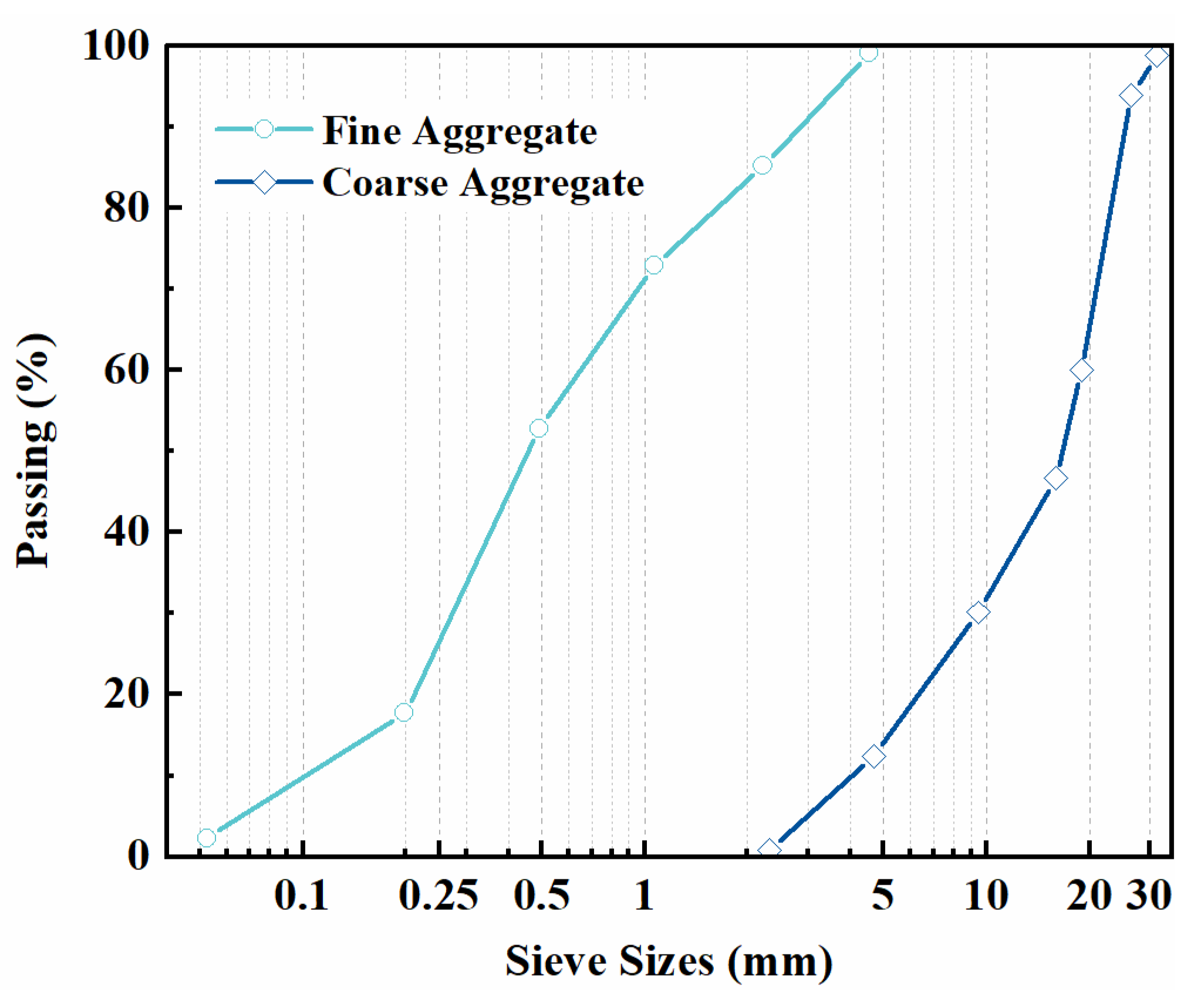
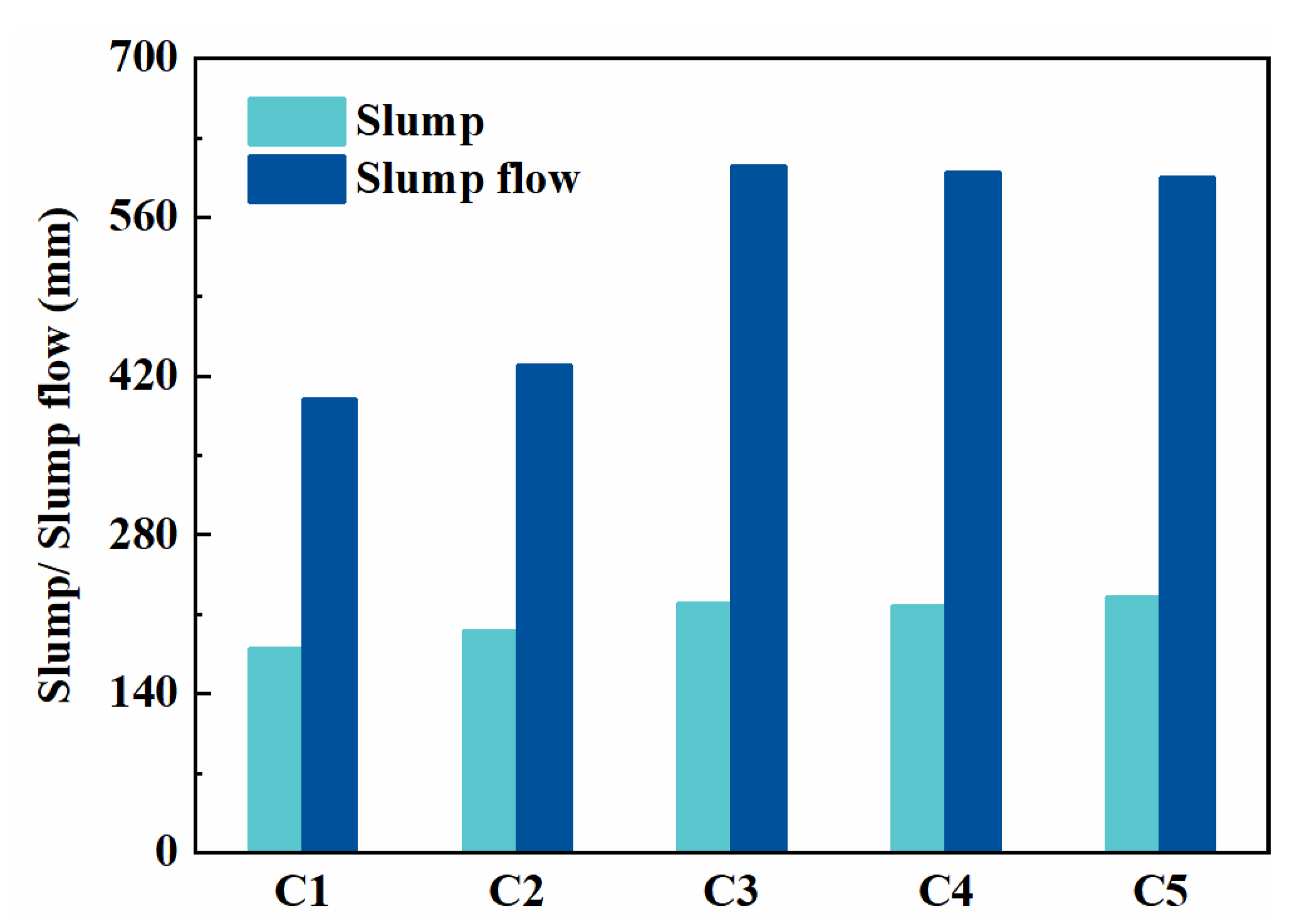
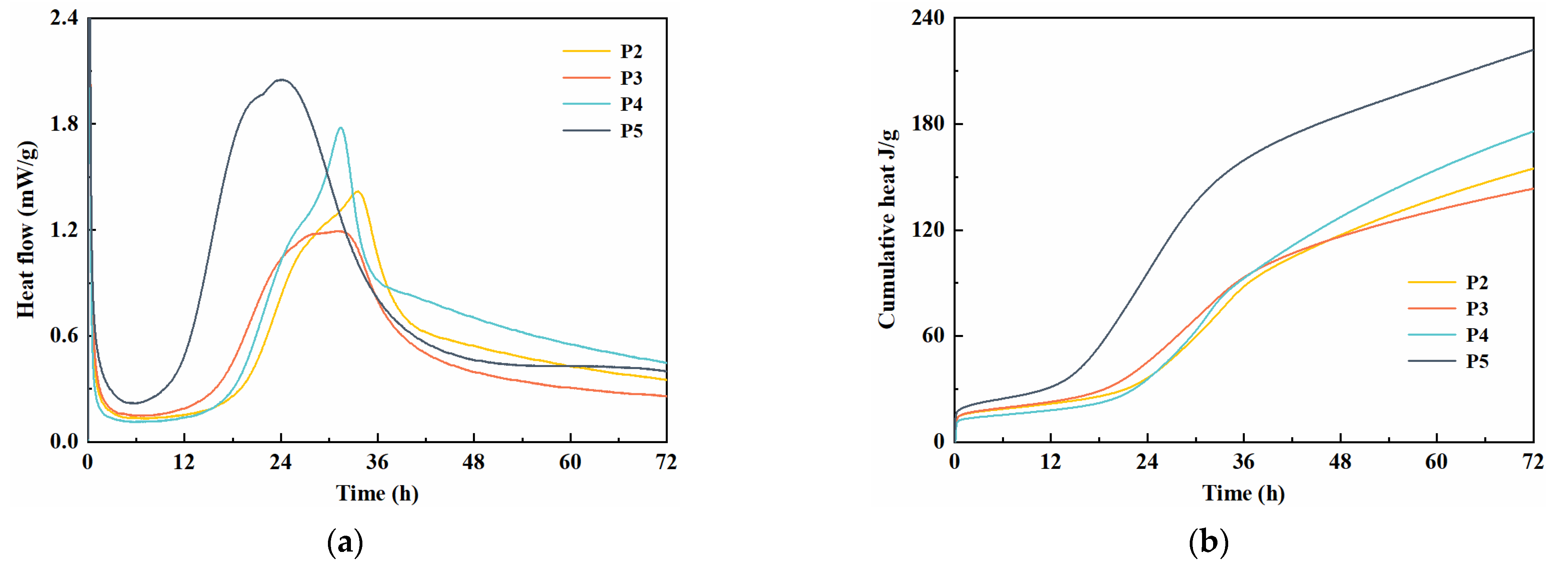
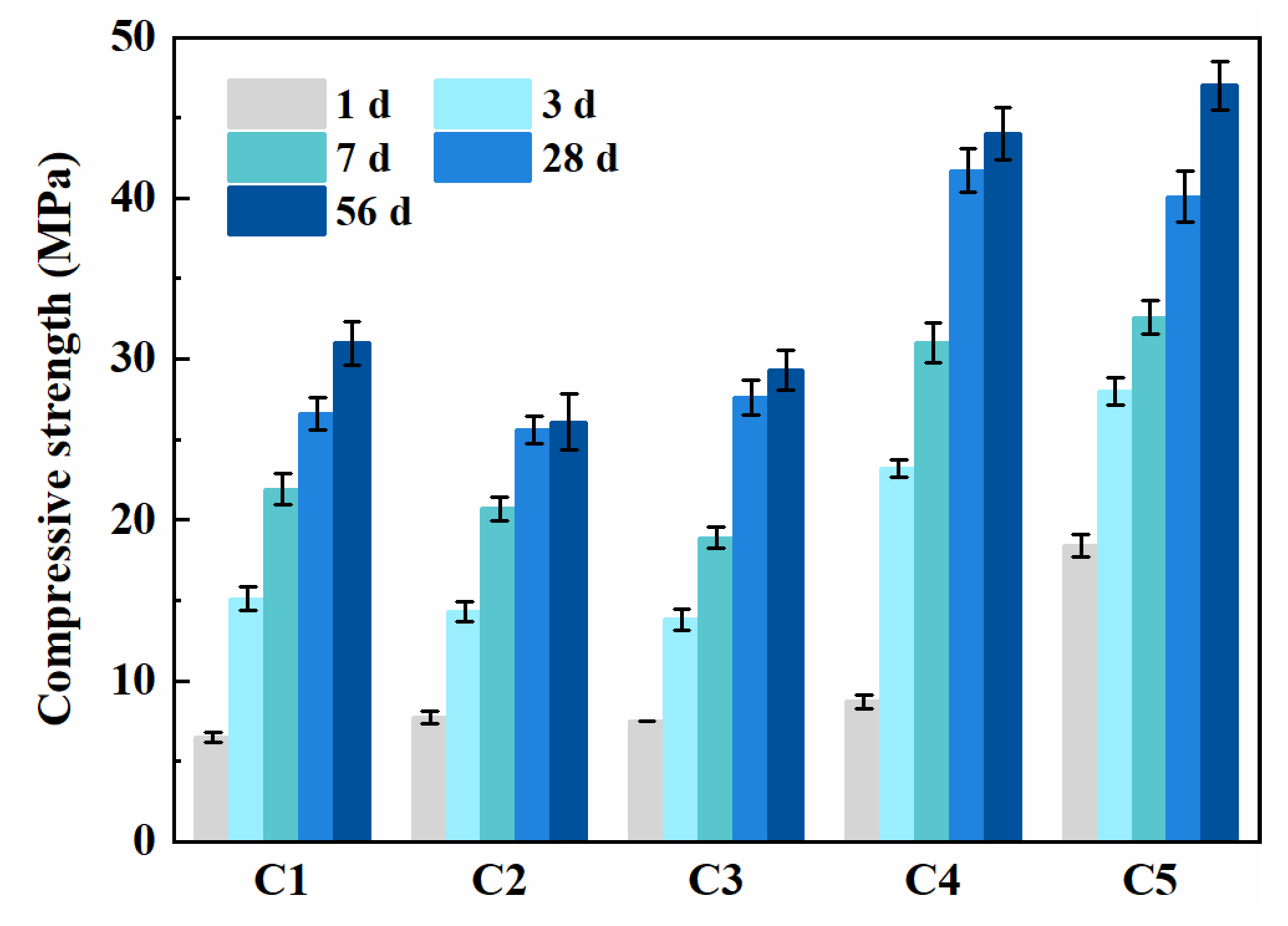
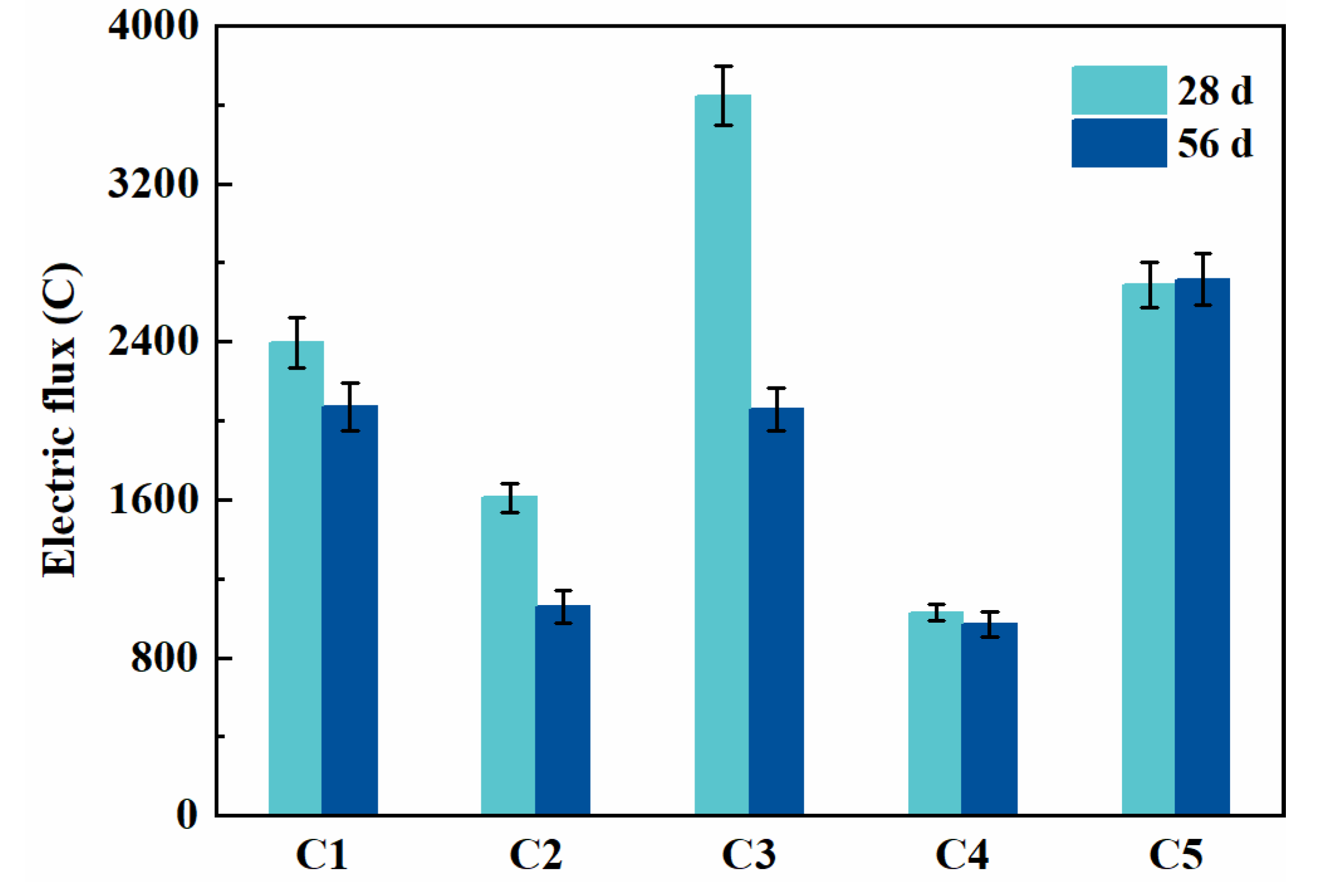
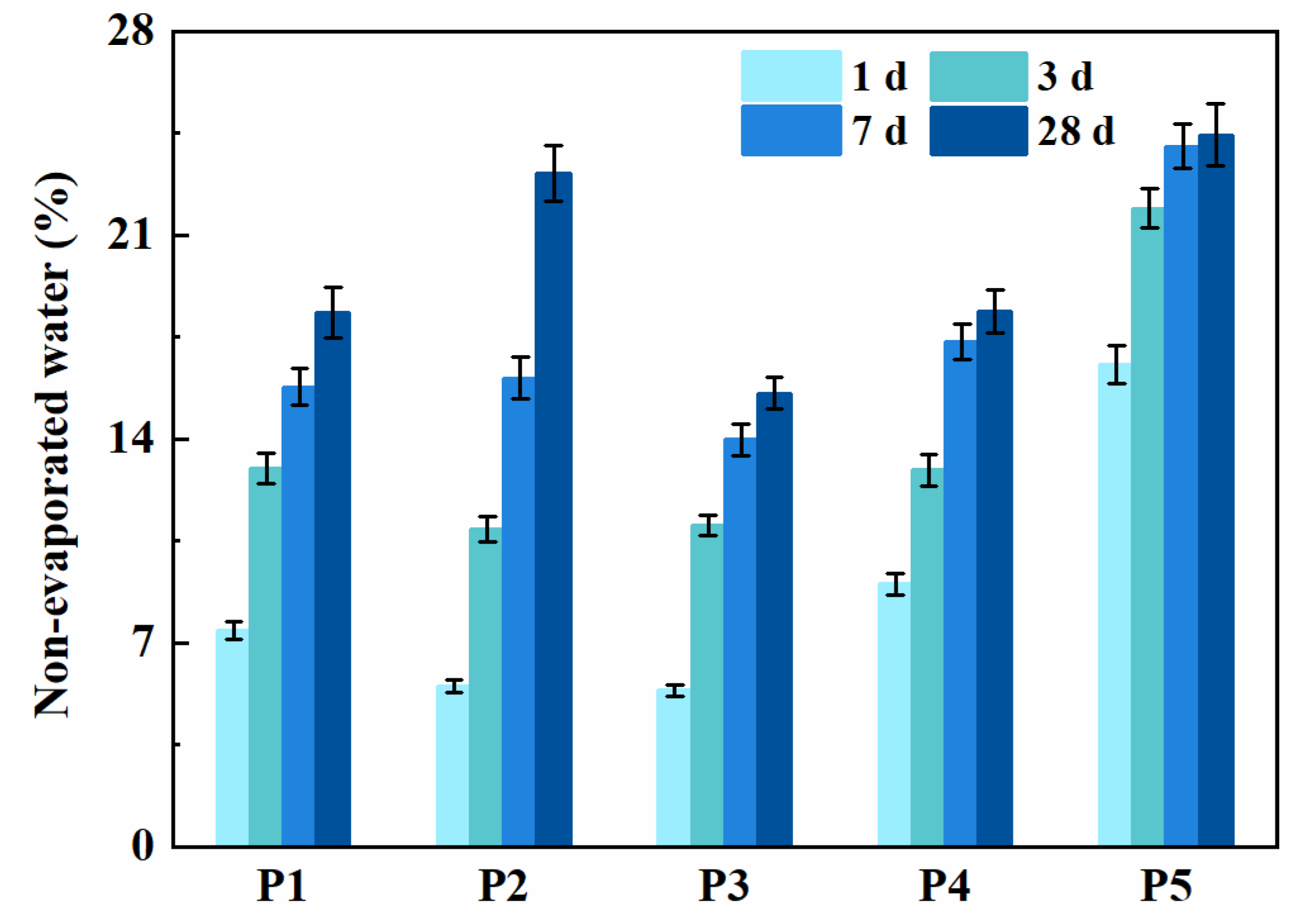
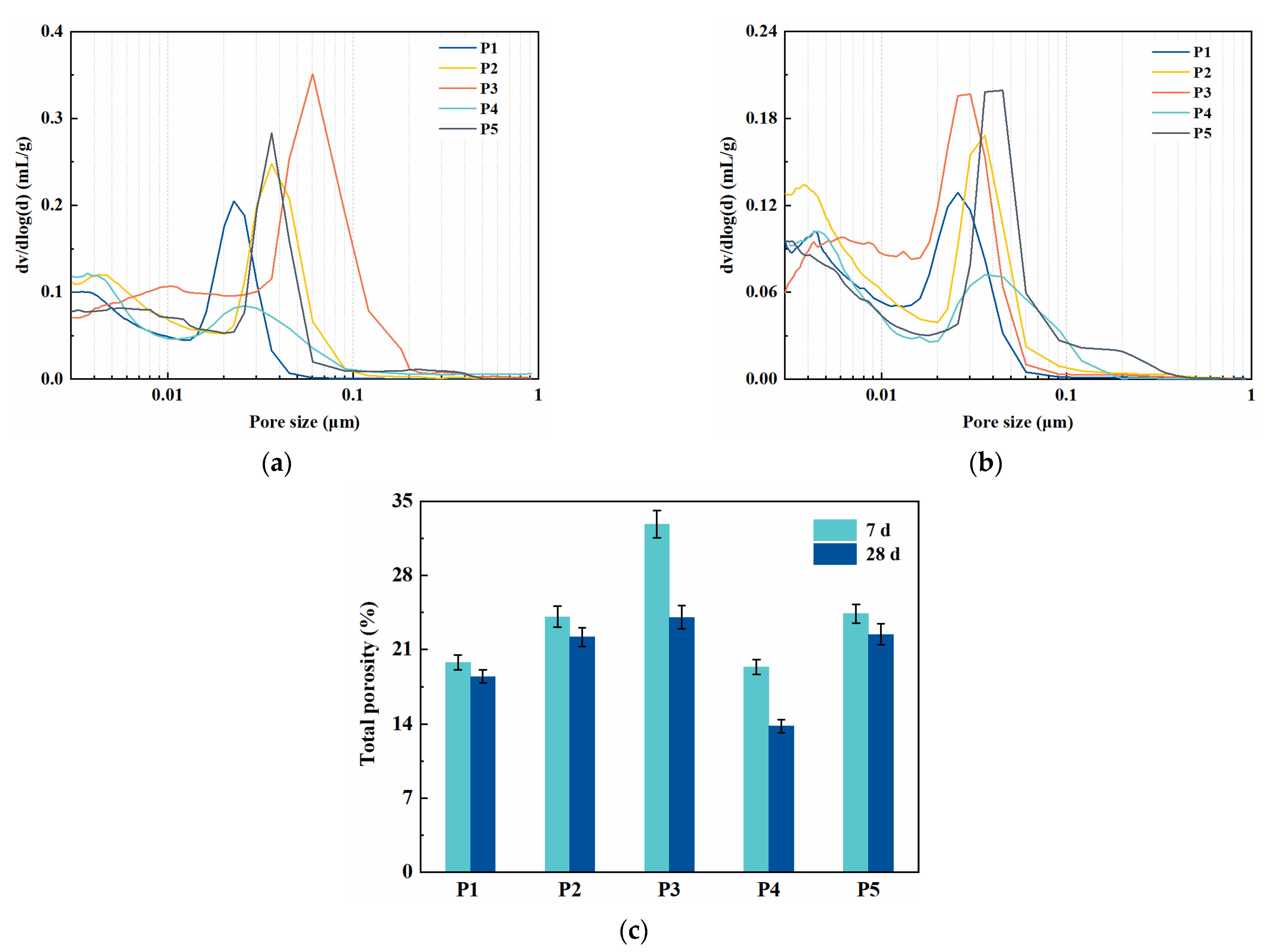
| Raw Materials | Al2O3 | SiO2 | CaO | SO3 | Na2O | K2O | MgO | P2O5 | TiO2 | Fe2O3 |
|---|---|---|---|---|---|---|---|---|---|---|
| Cement | 7.01 | 24.80 | 57.1 | 2.43 | - | 2.11 | 0.96 | 0.04 | 0.29 | 3.14 |
| Fly ash | 22.80 | 46.40 | 5.76 | 0.40 | 0.68 | 3.01 | 1.12 | 0.25 | 0.85 | 6.15 |
| Slag | 13.00 | 28.30 | 40.3 | 2.67 | 0.28 | 0.27 | 7.74 | - | 0.79 | 0.78 |
| No. | Cement | Slag | Fly Ash | Fine Aggregate | Coarse Aggregate | Water | Superplasticizer | |
|---|---|---|---|---|---|---|---|---|
| Type | Percentage (%) | |||||||
| C1 | 200 | 80 | 100 | 812 | 1033 | 171 | NS | 1.00 |
| C2 | 200 | 80 | 100 | 812 | 1033 | 171 | PCE | 0.8 |
| C3 | 200 | - | 180 | 812 | 1033 | 171 | PCE | 1.30 |
| C4 | 200 | 180 | - | 812 | 1033 | 171 | PCE | 1.40 |
| C5 | 380 | - | - | 812 | 1033 | 171 | PCE | 1.60 |
| No. | Initial Setting (min) | Final Setting (min) |
|---|---|---|
| C1 | 490 | 620 |
| C2 | 435 | 585 |
| C3 | 630 | 760 |
| C4 | 750 | 870 |
| C5 | 450 | 540 |
Publisher’s Note: MDPI stays neutral with regard to jurisdictional claims in published maps and institutional affiliations. |
© 2021 by the authors. Licensee MDPI, Basel, Switzerland. This article is an open access article distributed under the terms and conditions of the Creative Commons Attribution (CC BY) license (https://creativecommons.org/licenses/by/4.0/).
Share and Cite
Yang, Z.; Liu, S.; Yu, L.; Xu, L. A Comprehensive Study on the Hardening Features and Performance of Self-Compacting Concrete with High-Volume Fly Ash and Slag. Materials 2021, 14, 4286. https://doi.org/10.3390/ma14154286
Yang Z, Liu S, Yu L, Xu L. A Comprehensive Study on the Hardening Features and Performance of Self-Compacting Concrete with High-Volume Fly Ash and Slag. Materials. 2021; 14(15):4286. https://doi.org/10.3390/ma14154286
Chicago/Turabian StyleYang, Zhenghong, Sijia Liu, Long Yu, and Linglin Xu. 2021. "A Comprehensive Study on the Hardening Features and Performance of Self-Compacting Concrete with High-Volume Fly Ash and Slag" Materials 14, no. 15: 4286. https://doi.org/10.3390/ma14154286
APA StyleYang, Z., Liu, S., Yu, L., & Xu, L. (2021). A Comprehensive Study on the Hardening Features and Performance of Self-Compacting Concrete with High-Volume Fly Ash and Slag. Materials, 14(15), 4286. https://doi.org/10.3390/ma14154286






